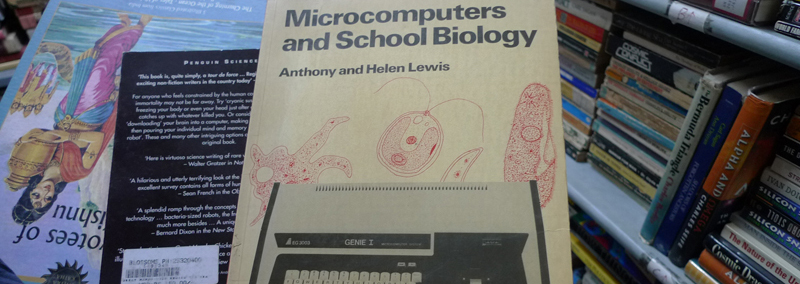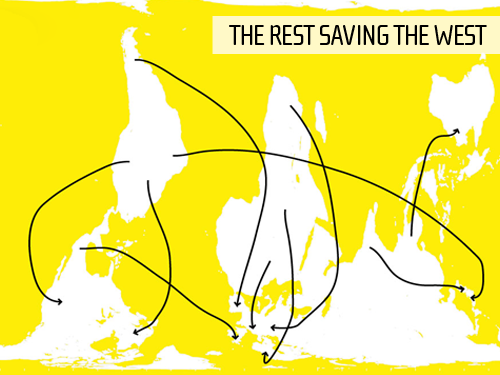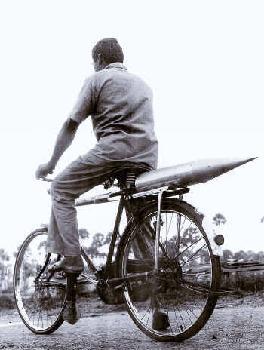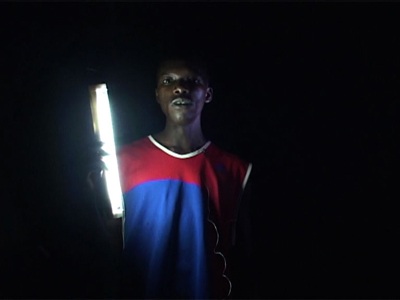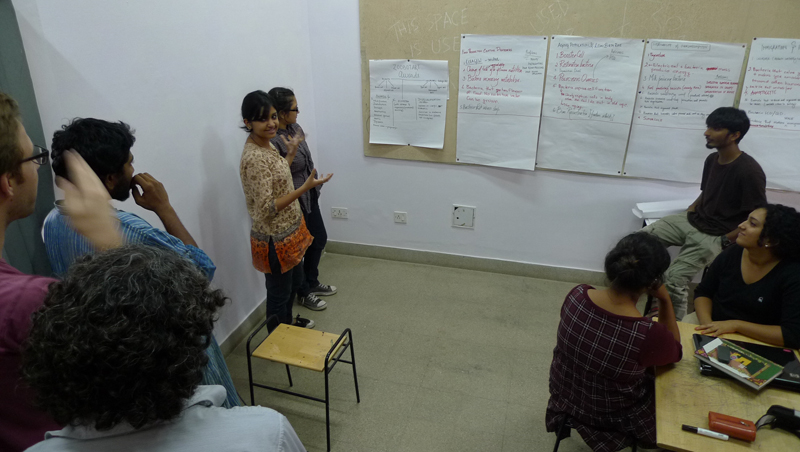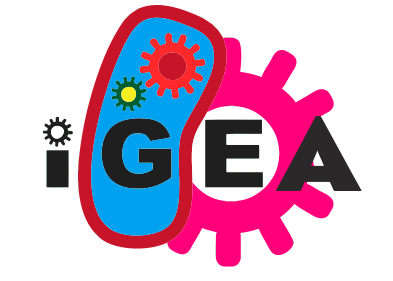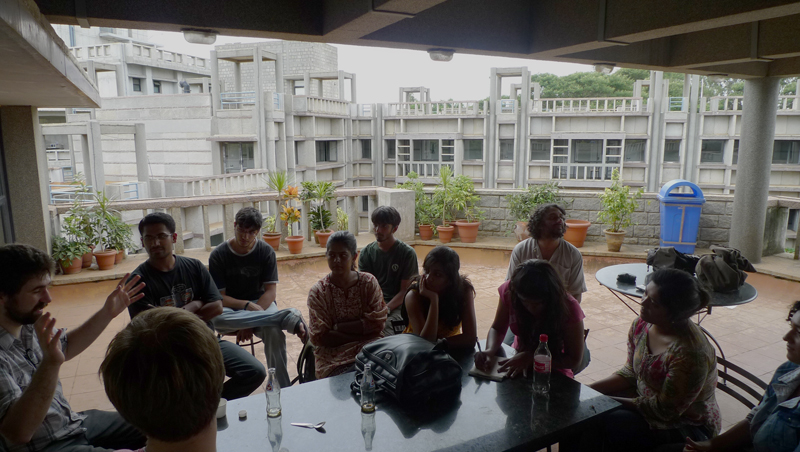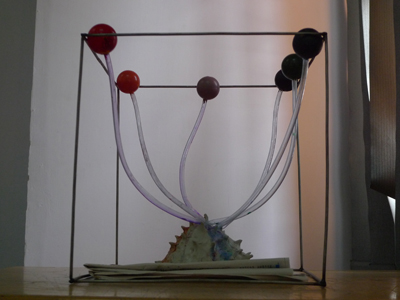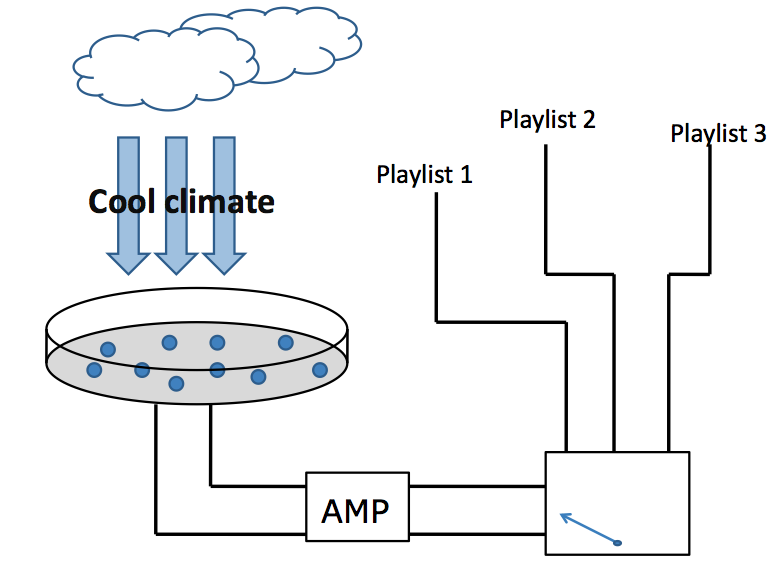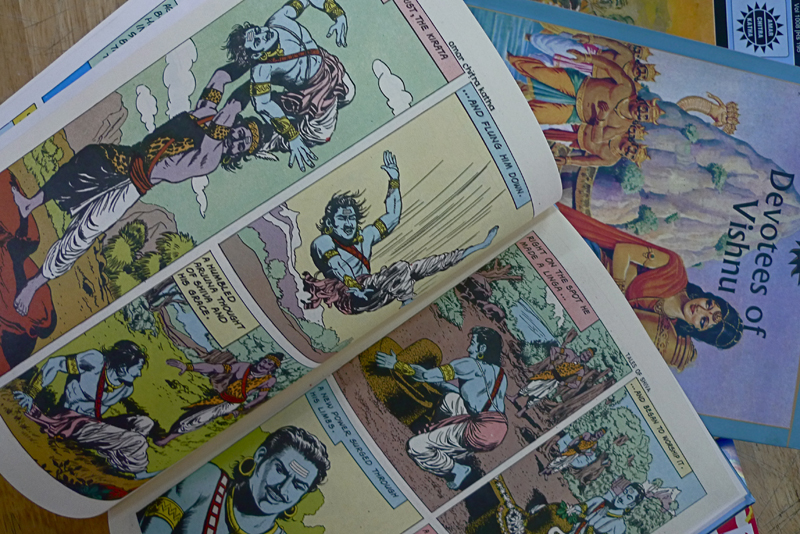DesignWorkshop2010
This page documents the art/design workshop run by Alexandra Daisy Ginsberg and James King with Yashas Shetty and the ArtScienceBangalore iGEM 2010 team.
We've joined for two weeks to help the team generate ideas for iGEM 2010 (James is here longer).
This week, we're exploring the role of art and design in synthetic biology and iGEM, and trying to generate new ideas about what this contribution might be!
Contents
Monday 14th June: Reverse Engineering Workshop
Day 1 started with the team showing us what they've been up to the last three weeks.. an amazing journey from the history of microbiology to DIY lab equipment (including an incredible 7000rpm hand-held centrifuge made from an egg beater) to visits to the National Center for Biological Sciences.
We showed our work with other synthetic biologists, covering topics such as the difference between natural and synthetic forms of life, the promise and compromises of synthetic biology, new manufacturing processes, iGEM and finally the way that the concept of life might change due to synthetic biology.
As a group of artists and designers competing in a competition set up for engineers and scientists we need to think about how we can make a meaningful contribution without emulating the approach of science-based teams. As a group we found we were skeptical of the engineer's view of biology and wanted to explore alternative visions and ways of manipulating life. What would be the reverse of engineering?
The Rest Saving the West
Quite a few of the projects of previous iGEM teams are aimed at providing solutions for Third-World problems: Bacteria that detect arsenic in drinking water or cadmium contaminated food and bacteria that kill mosquitos larvae. Very few iGEM projects aim to solve first-world problems, such as Todai Tokyo's attempt to tackle lifestyle diseases.
So we asked the team to imagine they were entering the rather wonderful Designs for the First World competition as a team of tongue-in-cheek Synthetic Biologists from India trying to solve the problems plaguing the West:
- Food Production and Eating Disorders
- Aging Population and Low Birth rate
- Immigration and Integration to Society
- Sustainability and Over consumption
After a group brainstorm the team came up with loads of ideas, highlights are below:
Food Production and Eating Disorders
- Bacteria Salad - Bacteria that has the flavour and consistency of food but with none of its nutritional value - just like salad.
- Moo.coli - Bacteria that replace cows in milk-production.
Aging Population and Low Birth rate
- The Booster Cell - a cell with packed with mitochondria that latch onto the cells of the host organism (in this case, old people), giving them more energy.
Immigration and Integration to Society
- Coloreria - Melanin controlling Bacteria.
- Testosterone reducer - Bacteria that reduces and regulates testosterone in men, thus controlling crime in society.
Sustainability and Over consumption
- Purgcaelum - Bacteria that filters pollution
- A bacterial substitute for wood
Tuesday 15th June: Jugaad Biology
The first Indian rocket was transported to the launch site by bicycle. source
"Jugaad is a survival tactic, whereas a hack is an intellectual art form; i.e. Jugaad is the wile of the poor, and hack the pastime of the affluent cerebral. Jugaad is a hack to get around or deal with a lack of or limited resources, and has a class component to it - jugaad are things poor but clever people do to make the most of the resources they have. They do what they need to do, without regard to what is supposed to be possible."
A new paper by Maureen O'Malley at Exeter University describes synbio as a 'kludge': Making Knowledge in Synthetic Biology: Design Meets Kludge. A kludge is
an ill-assorted collection of parts assembled to fulfill a particular purpose - it's a bit like jugaad, a new word James and I learnt today. We watched Kempinski, a mysterious science fiction short. Simple and shot on a very low-budget, Kempinski is a documentary of a future somewhere in Africa, its realistic inhabitants living in a strange mystical world. The interviewees discuss their existence showing the only artifacts of this other realm - fluorescent strip lights - somehow imbued with animist power.
This morning, we looked at the ways synbio might be hacked in unexpected ways. Starting with a talk on the Promise and Peril in Synthetic Biology, we discussed the social, ethical and cultural issues raised by synbio. We discussed synbio hype, who benefits, and the critics of synbio. With the BP oil spill and Bhopal Gas Tragedy in our minds, what might the synbio version of engineering failure be? What is the grey area between the disaster of bioterror/bioerror, or the perfect sustainable future we're promised?
This is the list we all came up with:
- Bioterrorism
- Bioerrorism
- Irresponsible Promotion: Artists irresponsibly appropriating technology - lack of criticality?
- Creating Monsters... bad design
- Destruction of natural ecological networks – foreign species
- Bandwagon – throwing money at inappropriate technology and solutions? (Global rather than local solutions/politics)
- Blind Faith: Making it just because you can, not questioning why doing it – new farmed-out mass technology is a synbio lab.
- Environmental disaster… things escape that are fine in the lab, that reproduce
- Synbio’s Paradox It’s safe because it can’t escape and isn’t robust outside the lab. Yet we have applications that will be put into the environment!
- Intellectual Property who owns the technology. Should corporations be allowed to patent DNA? Are we making something new – so that can be patented?
- Is their interest the community? Who will control the licensing?
- Bioprospecting taking things from nature and commercializing them
- Give and Take How can people be compensated – how to create a sustainable industry?
- Rate of Change Can policy and law keep up with the rate of change of technology
- Just because we can make it, should we?
- How do you govern it?
- Priority How do we prioritize what we want, where we want it?
- Unexpected wars… War because Middle East’s oil is no longer wanted!
- Getting left behind will everyone have to do it
- Increasing the imbalance Anti-malarials and fuel for the third world made in the Midwest.
News at One
The team split into groups of three, each selecting an iGEM project from any of the competition years, to imagine unexpected, unintended uses of this technology. We asked:
- Are we in the future, the present (or even the past)?
- How is it being used in an unexpected context or manner?
- How has it been hacked?
- Who is using it?
- Is it for a good or a bad purpose?
Inspired by two episodes of American comedy news show, the Colbert Report (on BP and Jay Keasling) each team presented a news item, telling us the story of a group of people using the technology in a completely unexpected way. Mukhund came over from NCBS to watch the show.
Today on News at One
- Sticky Situation Sex before marriage at risk as Glucoli found in condoms. Concerned mothers sabotaging daughters' boyfriends thought to be culprits.
- Anarchist Amalgamation BP claims latest oil spill found to be caused by GM bacteria released by terrorists. Sequencing shows cause from multiple commercial strains. Anarchist factory workers at the heart of the outbreak.
- Hair-Raising A new technology designed to switch genes on and off is being used to combat Alopecia and premature balding. A cosmetic industry hack of medical technology causing a trend as consumers found standing under light sources before a special date to cover up bald spots and grow glossy heads of hair.
iGEA Prelims! - Afternoon workshop
Having stepped into the realm of the impossible and the sci-fi future, we wanted to bring back the idea of Jugaad Biology - the artist and the scientist using the hack or kludge.
- What is the iGEA competition - the International Genetically Engineered Art Competition?
- What categories are there?
- What prizes can be won? How do people communicate their work?
- What might be disqualified from entering?
The three competition proposals:
Samrajni, Anusha, Shreya
- Awards: Most Critical of the Social System, Most Socially Controversial, Most Influential on Pop Culture, Best Peer Review, Best Concept, Best Expressed Idea, Best Negative Emotion Evoked,Best Positive Emotion Evoked, Best Use of Colours;
- Prizes: Monetary incentives, recognition;
- Disqualification: Plagiarism, Not Breaking Biosafety Laws.
Karthik, Aaron, Sayed Represent the Concept of Life
- Awards:Best Social Critique, Best Use of Colour,Best Visual Aesthetics, Most Innovative Concept, Best Pattern & Texture, Most Thought Provoking, Best Abstract Work, Most Eco, Gestalt Award;
- Disqualification: None- everything is valid;
Mohor, Sankhalina, Akshitta Zoobotart
- Categories: Plants - Thorn-Art, Pigment Art, Flower Art; Microbes - Collage Art, Dye Art; Light Art, Movement Art
- Awards I: Modification,Installation,Concept, Aesthetics,Survival period, Static/Dynamic, Future Uses - purposeful; II: Ecosystem: With at least 3 organisms (modified) surviving
- Disqualification Criteria: Useless or useful but harmful, Survival in extreme conditions but death not accepted
Before discussing the competitions compiled by each of the three groups, we asked everyone: What do you, as artists and designers, bring to synthetic biology? A huge debate exploded!
- What are the differences and similarities between artists and scientists, their points of view, aims, boundaries, logic, constraints? What about design?
- Experimentation, subjectivity, tangibility, play, process, aesthetics? What about sensitivity and empathy?
- It's a new medium, but we don't know the limitations. Like paint, we need to mess around to learn! We've been learning the science, but we still need to break through the barrier. Scientists though tend to be constrained by what exists.
- Art as critique on society and self.
- Context - do designers have a broader approach than scientists who need deep knowledge?
- Art and science both exploring questions? Both can explore things the unconventional way.
- Is the end product or the process our priority? In science, is the end product the priority?
- Bad science, bad art...
- Plagiarism - is recombinent DNA plagiarising? How does open source fit in - remix culture.
- Is the difference similar to a chef making molecular gastronomy and a scientist engineering food?
We compiled the discussion into the ideal art/design iGEM competition.
Ready for the launch tomorrow... Could scientists enter iGEA to subvert it?
Wednesday 16th June: Welcome to iGEA 2010
iGEM started as class at MIT in 2003, evolving into an international competition. Today at Srishti we're launching iGEA, - The International Genetically Engineered Art competition - the art and design sibling of iGEM.
Powered by synthetic biology, iGEA explores how this emerging technology can be used for art and design purposes.
DNA parts submitted by teams to the Parts Gallery - an Open Source biological media library - may be used in new art and design works, and even by scientists...
We are an open source platform created to enable artists and designers to find new uses for synbio, to create new discourse about the science, and for implementing and exhibiting your creative projects at the interface of art and science.
Yesterday, we spent the afternoon designing the new competition, the awards and rules.
The Awards
- Best Ecosystem
- Best New Emotion
- Best Social Critique
- Best Pop-Culture
- Shooting Star (short-lived, burning bright)
- Remix Culture
- GRAND PRIZE: Gestalt Award
- Critics Choice for Visual Aesthetics
- Genetic Raspberry Award
Today, we're running the inaugural iGEA with 3 teams.
The competition rules:
What does your organism do, how did you make it, what is its impact, why does it fit in the category, what new parts did you have to make?
Make an art/science poster for your iGEA entry. What is an art/science poster?
To describe your project, you could also make artifacts, images, a film, a performance or a powerpoint to use as props in your presentation.
At the end of the day, we’ll be holding the iGEA competition presentations.
Prizes will be awarded; the Gestalt Award Winner will present their iGEA project at the National Centre for Biological Sciences tomorrow!
Good Luck!
Round 1
Combo categories were picked out of a hat by each team, and at the end of the day, first ideas were presented.
- Best New Emotion & Best Pop-Culture: Formal-in Culture Aaron & Sayed
Ants secrete and detect formaldehyde in order to structure the behavior of their colony. In order to manipulate the culture of an ant colony, Aaron and Sayed suggested that a bacteria could be engineered to inhibit formaldehyde production in ants: making the ants more individualistic.
- Best Ecosystem & Shooting Star: Yuga Bacteria (aka PastPresentFuture Bacteria) Akshitta, Shreya & Anusha
Imagining a Hookah as an ecosystem, this team proposed to engineer a bacteria that produced powerful psychotropic drugs that could be inhaled and that would present visions of the past, present and the future.
- Best Social Critique & Remix Culture: DNA Remix Karthik, Mohor & Samrajni
This group proposed a future in which humans have learned to modify their biology, remixing the parts of other animals into their bodies. Wings for transport and shells for shelter.
Thursday 17th June: On Tigers and Small Disasters
A discussion on designing from our local, personal perspective as opposed to global was an interesting precursor to our visit to the National Centre for Biological Sciences (NCBS).
We presented along with Zack Denfeld to the NCBS scientists, Srishti staff and an interesting mix of academics and NGO's. The team had the mixed pleasure of hearing the talks again (sorry!) but in a new context: inside the scientific establishment. Did we change the way we spoke? What kinds of critique did we encounter from the NCBS scientists? The discourse continued in the NCBS garden with the scientists, amongst spice plants curated as part of an exhibition on historical bioprospecting, Such Treasure and Rich Merchandize.
In the afternoon, with a view over NCBS, we discussed as a group. How do we feel about technology and what happens when it fails? After these last few weeks, how does everyone feel about synthetic biology? Some interesting points about the social constructs around science were raised in the morning presentations, like the example of a GM wheat introduced into India that failed - women were uncomfortable kneading it as the ground grain texture wasn't right to make local foods.
Should we just accept it and move forward? Can we deny progress? An interesting idea was raised - that we can only learn about how to handle a technology by a failure, perhaps even a small one, effectively 'inoculating' society against future grand disaster. So what is a small disaster? Deepwater Horizon is a certainly a grand oil disaster, despite countless previous spills.
Zach got controversial: tigers! With just 1444 left, could a bacteria be engineered to specifically target these national treasures? So rare, their loss wouldn't have much impact on the ecosystem, but it would raise huge debate about what we want from a technology. 'Cute megafauna' touched our hearts more than the extinguishing of the sun.
iGEA day 2
Back to Srishti to work on the iGEA entries, this time, to develop a bacteria within the realms of the scientifically possible. Each group has to make an artifact and represent it in a film to tell the story of the iGEA bacteria. Developing the ideas from Wednesday, each group kept the same categories.
- Best Ecosystem & Shooting Star (short-lived, burning bright)
- Best New Emotion & Best Pop-Culture
- Best Social Critique & Remix Culture
The film should illustrate the working of the BioBrick in particular and organism in general, using existing BioBrick terminology.
The idea can be wild, but the science must be possible in 2010!
Friday 18th June: Telling Tales
This morning, the iGEA teams presented their films and artifacts, made since last night!
Model of the Glandotransius
The Glandotransius Akshitta, Shreya & Anusha
The Glandotransius is an engineered E.coli that stimulates various glands in the human body. It accentuates the effects of certain hormones. It produces DMT, Dimethyltryptamine, a chemical produced by the pineal gland, found in almost all plants and mammals and a hallucinatory, dangerous drug. The Glandotransius stimulates the ecosystem of the various glands, from the testes to the hypothalamus. While the pineal gland is synonymous with Shiva’s Third Eye, its over-stimulation may also bring with it lack of perception leading to lack of communication, a plethora of psychological and physical problems and long term effects like permanent damage to the immune and central nervous system.
E.cloudy Mohor, Samranji & Farhad
Bacteria which help coordinate your music with the weather. E.cloudy is a Bacteria which is temperature sensitive and produces electricity. The E.Cloudy bacteria contain two existing BioBrick parts – BBa_K098995, responsible for the thermo sensitivity.(Designed by Harvard 2008 IGEM team) and BBa_K499271, responsible for the electricity (designed by Boris Kirov IGEM 2010).
Apart from being aware of the weather, it creates awareness in how two very different genes, from possibly two very different organisms have been put together to create a machine. It could lead us to questioning our rights to remix things, whether it is OK to mix the machine with living cells, and our rights to play with natural selection. Can we define this as a form of natural selection?
Formal-in Culture Aaron & Sayed
Next, a lecture on Telling Tales...
How are science stories told?
Telling stories through artifacts...
- The Toaster Project
- The Golden Institute
- Macguffin Library
- Feelings are Facts
- Cloaca
- Miller-Urey Experiment
- Man in the White Suit
- Spirited Away
Telling stories about stories
We looked at film posters from around the world thinking about the art/science poster question... Ghana, Poland and India. What are local genres for story telling?
